Introduction & Specifications, Pricing, and Availability
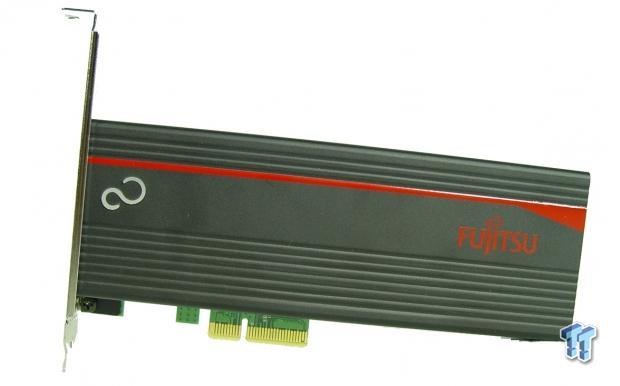
We started our Fujitsu F100 review out with this statement:
Fujitsu Asia Pacific Ltd is a subsidiary of Fujitsu, and a company large enough to need no introduction. This subsidiary of Fujitsu has made a lot of noise in Asian computer DIY markets with a trio of SATA III, and a unique PCIe SSD for the consumer market.
The same holds true for today, but instead of testing a run of the mill SATA III SSD with a Silicon Motion SM2246EN controller, we're testing the unique PCIe SSD from Fujitsu.
Fujitsu calls their adaptation to PCIe All-in-One RAID SSD the Quadro-M PCIe. The drive uses a Marvell PCIe 2.0 four-lane RAID controller to four SATA III. To keep things simple, the Quadro-M comes equipped with four Intel mSATA SSDs with eMLC NAND flash, all packaged in an easy to install configuration.
The drive we're testing today is an early sample. At this time, the Quadro-M is not available for sale, but that should change in the coming months.
Specifications, Pricing, and Availability
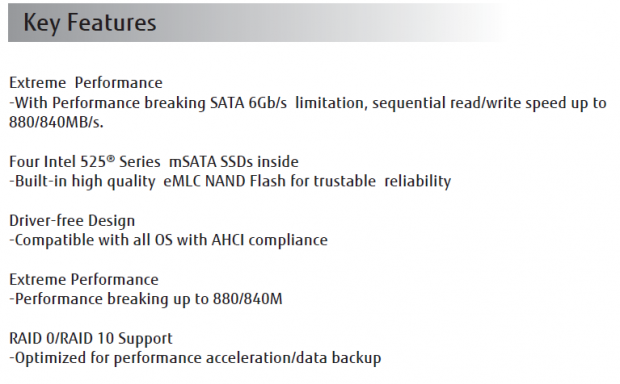
Fujitsu plans to release the Quadro-M in three capacities: 240GB, 480GB, and 720GB. The first two capacities are easy to get to - just four 64GB drives for the 240GB, and four 120GB drives for the 480GB. The 720GB model will use 180GB mSATA SSDs in RAID 0.
The largest capacity model should deliver Fujitsu's claimed 880 MB/s sequential read and 840 MB/s sequential write. When we tested all five capacities from Intel's 525 Series, we learned that the 180GB models performed very closely to the 240GB models, but the 120GB was slower than both by a decent margin. That means the 480GB Quadro-M we're testing today should be a bit slower than the claimed 'up to' performance.
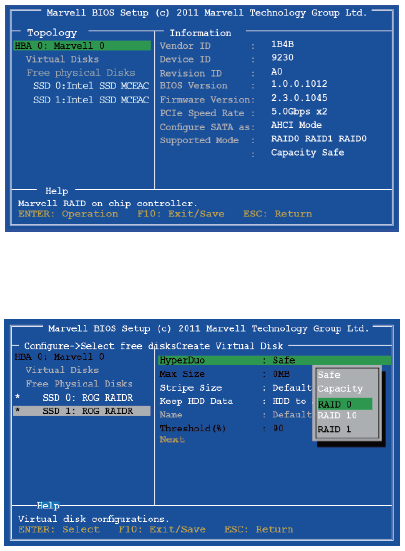
Users looking for a certain level of data protection can configure the array in RAID 10, but will lose half of the overall capacity when doing so. Using RAID 10 will also come with a performance penalty. The Quadro-M uses a Marvell 88SE9230 PCIe to SATA controller. This ARM based processor allows users to configure the RAID functionality in BIOS, just like any enterprise grade RAID controller. Several motherboard manufacturers also use the 9230 on upper-tier motherboards designed for the enthusiast market.
At this time, we don't know much about pricing, but we do know the Fujitsu Quadro-M will have a three-year warranty, and will mainly be available in the APAC region.
Fujitsu Quadro-M 480GB PCIe SSD

We don't have the retail packaging for the Fujitsu Quadro-M 480GB sample, but this is a preview article, so we're just focusing on what we have in hand. We brought the Quadro-M back with us from Computex, and we spent several hours with it. In its early form, we had issues getting the drive to work on some motherboards; this issue is common in the early stages of product development, and everything will be sorted before the drive hits the retail market.
Here we see the front aluminum cover that protects the components under the lid. The PCIe connector is four-lane, so the Quadro-M will fit in a wide range of PCIe slots from four-lane to 16-lane.
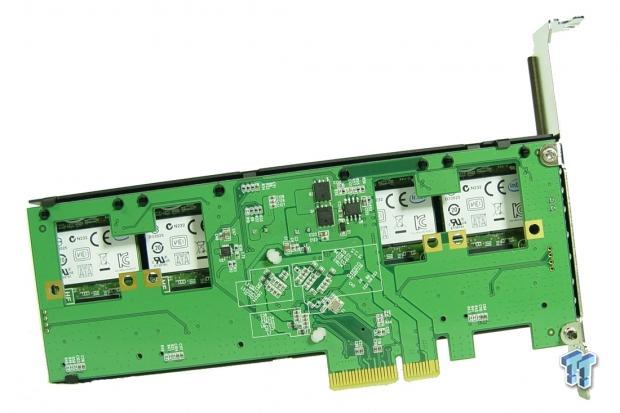
The back of the drive has an opening for air to pass through, keeping the four mSATA SSDs inside cool.
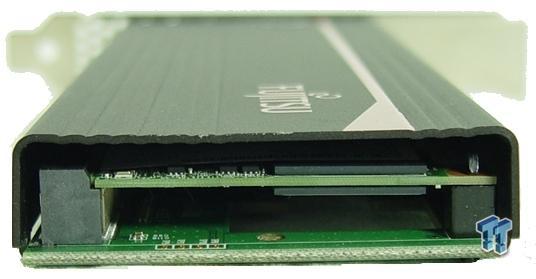
Air can also pass through the card....

...and escape through the backplane. This design helps to keep the Quadro-M cool, and even allows your nearby PCIe devices to run cooler, as more air will pass through the PCIe area.

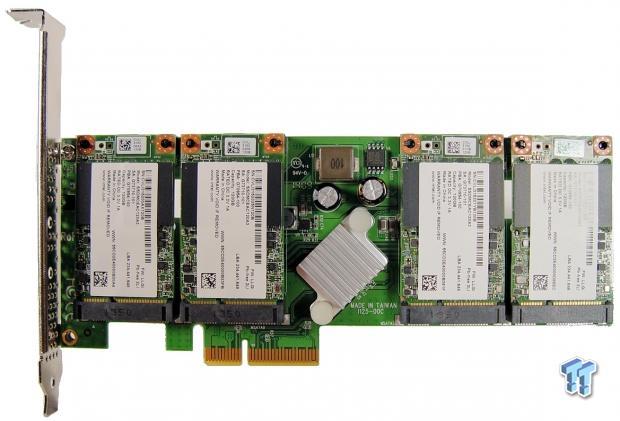
With the cover off, the four mSATA SSDs are exposed. Fujitsu uses Intel flash on all of the company's products. This has to do with Intel's reputation for flash quality.
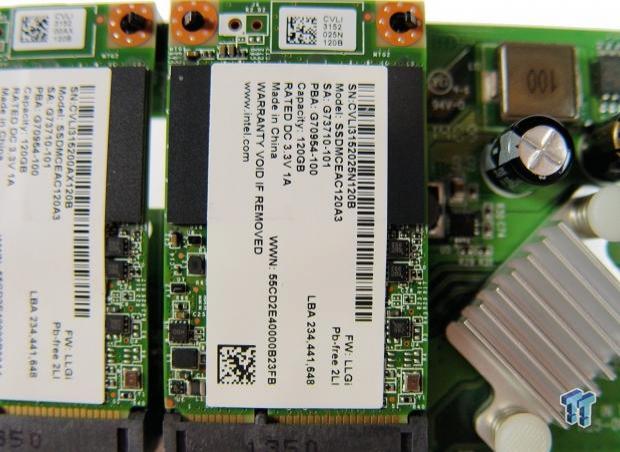
The drives come from Intel's 525 Series. In our sample, we had four 120GB Intel 525 Series mSATA SSDs.
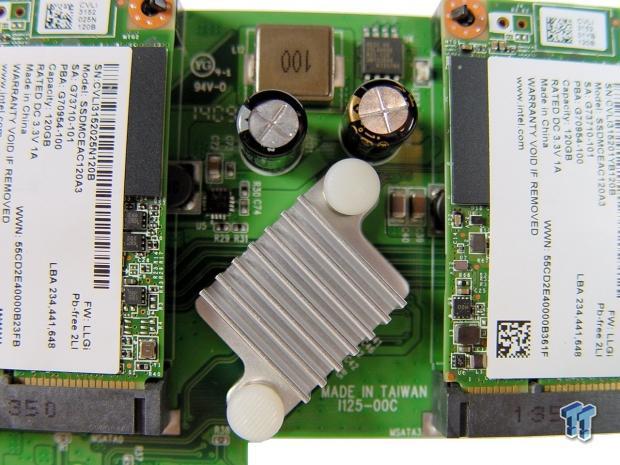
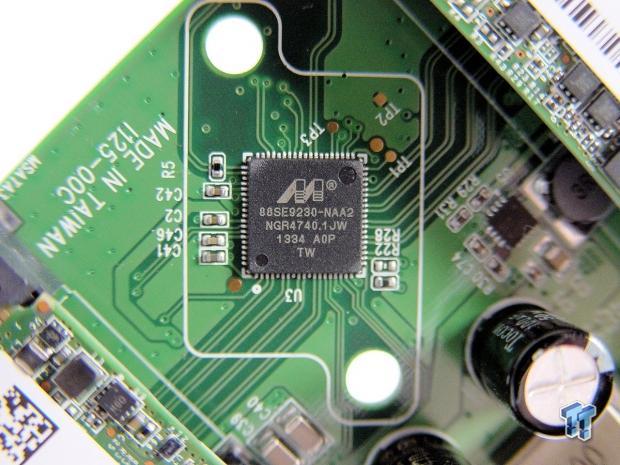
The Marvell 88SE9230 chip has a heat sink over it to aid in cooling. We've seen these on motherboards without heat sinks before, and we have not had an issue with high heat output under load.
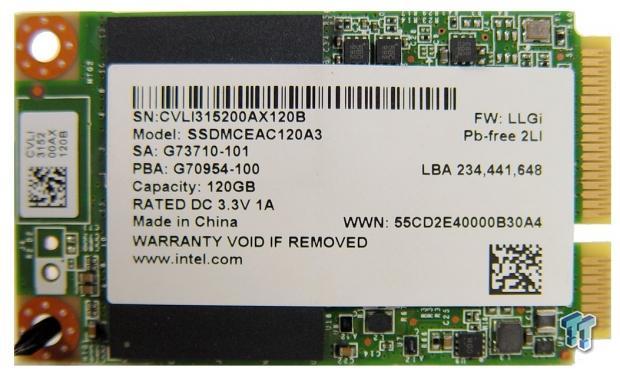
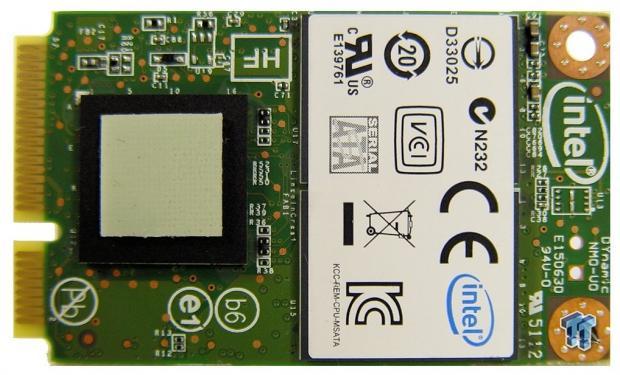

The 525 Series uses SandForce SF-2281 controllers.
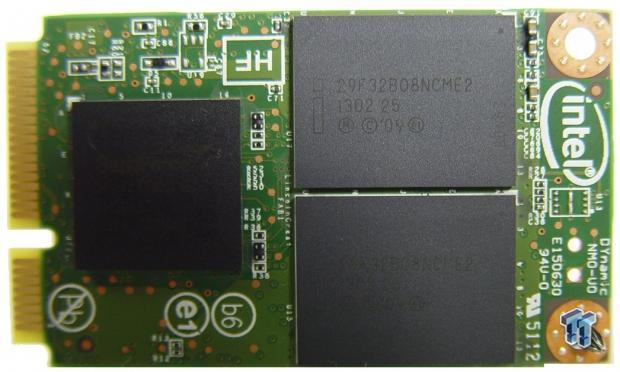
As mentioned, the flash is from Intel. These are 20nm ONFi die in Intel packages.

The mSATA drives slide into mSATA adapter slots, and the SSD snaps into place.
Test System Setup and ATTO Baseline Performance
Desktop Test System
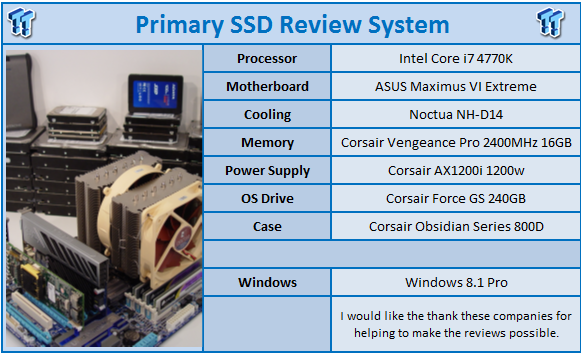
Lenovo T440 - Notebook Power Testing with DEVSLP and Windows 8.1 Pro
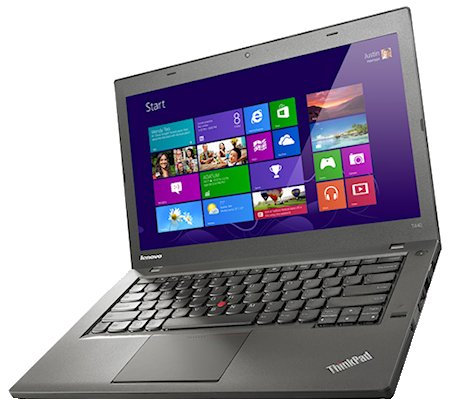
Nearly all of the performance tests run on the desktop system, but we use a Lenovo T440 to run the power tests. The T440 is the latest addition to our client SSD test lab, and allows us to test the notebook battery life offered by a SSD with advanced features like DEVSLP enabled.
ATTO - Baseline Performance
Version and / or Patch Used: 2.34
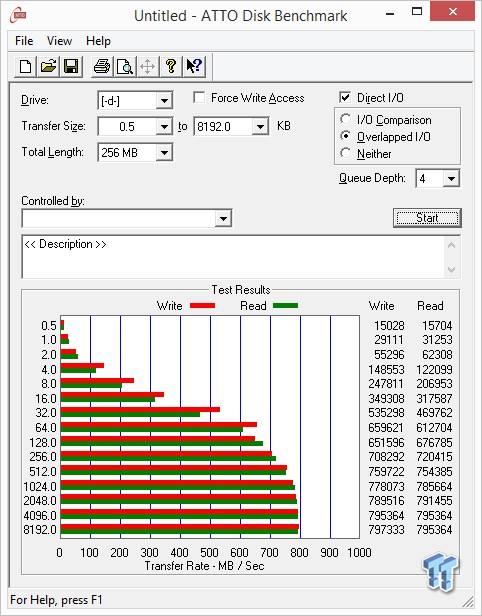
We mentioned in the introduction that the 480GB model we have on hand today wouldn't be able to match Fujitsu's 'up to' performance claim. We were surprised at the level of performance we did manage to squeeze out of the Quadro-M. In ATTO, at a queue depth of four, we hit 795 MB/s sequential read and 797 MB/s sequential write speeds. It's not 880/840, but it's pretty damn fast.
Benchmarks - Sequential Performance
HD Tune Pro - Sequential Performance
Version and / or Patch Used: 5.50
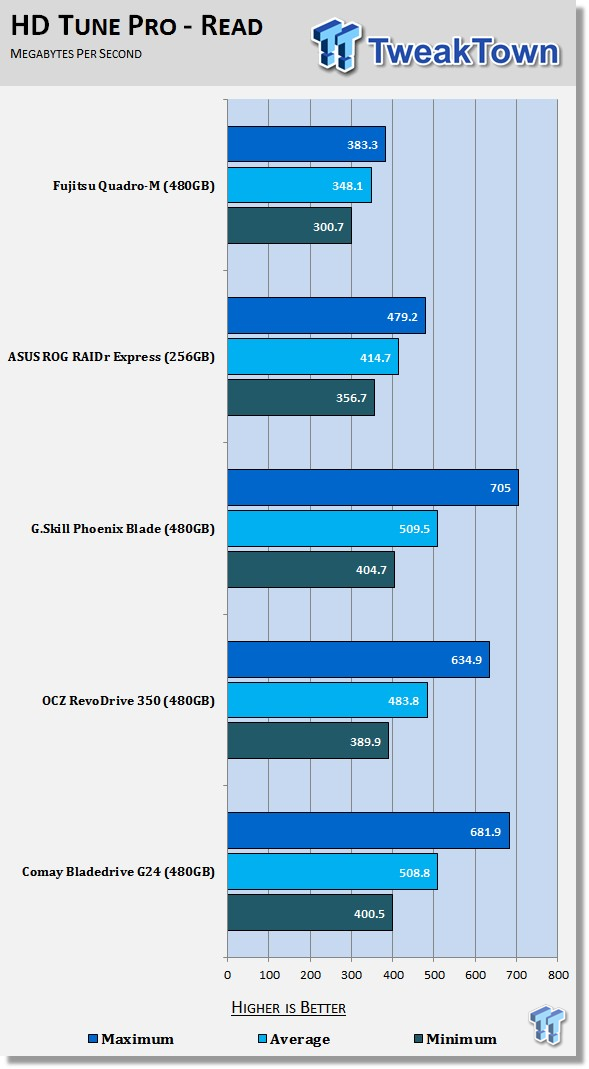
RAID benefits greatly from more than one IO request at a time. One issue we've found on many of the All-in-One RAID products is single queue depth read or write performance suffers compared to a single SSD in very low queue depths. Here we read across the entire user LBA span at QD1 in 64KB sequential blocks. The Fujitsu Quadro-M delivers an average sequential read performance of 348 MB/s. Later in this review, we'll test the drive at higher queue depths, and the performance will increase significantly.
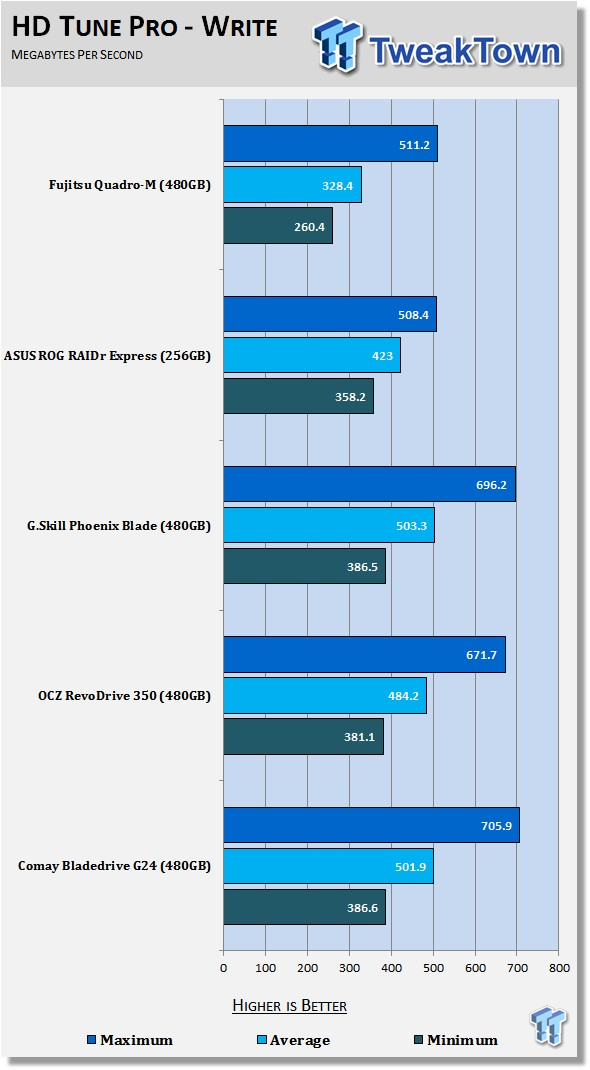
In this test, we swap the reads for writes, again going over the entire user LBA range. We had an average score of 328 MB/s, but the peak performance topped 511 MB/s.
HD Tach - Sequential Write Performance after Random Writes
Version and / or Patch Used: 3.0.4.0
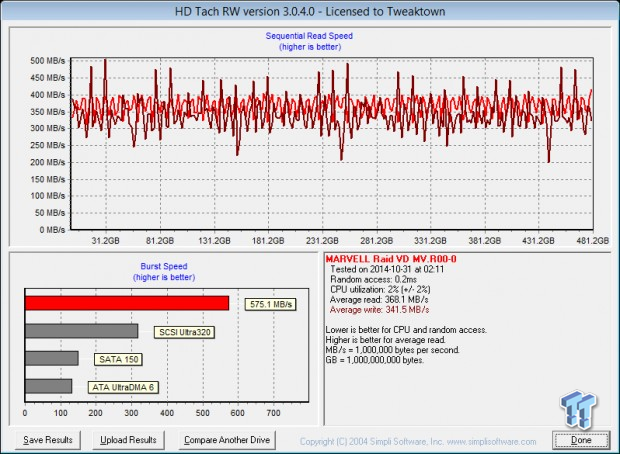
After a number of sequential and random writes to the drive to start the garbage collection process, we tested it again, this time with HD Tach to measure real-world sequential performance. The Fujitsu Quadro-M 480GB walked away with an average sequential read of 368 MB/s, and the sequential write was 341 MB/s.
More importantly, the drive didn't have many large performance drops when writing data. The lowest we scored was just over 200 MB/s. It's common to see drops that get under 100 MB/s with some consumer SSDs, and value-class models can dip well below that.
Benchmarks - Anvil Storage Utilities
Anvil Storage Utilities
Version and / or Patch Used: RC6
So, what is Anvil Storage Utilities? Well, it's a storage benchmark for SSDs and HDDs where you can check and monitor your performance. The Standard Storage Benchmark performs a series of tests; you can run a full test, or just the read or the write test, or you can run a single test, i.e. 4k QD16.
Anvil Storage Utilities is not officially available yet, but we've been playing with the beta for several months now. Anvil has been updating the software steadily on several international forums, and is adding new features every couple of months.
We can use Anvil several different ways to show different aspects for each drive. We've chosen to use this software to show the performance of a drive with two different data sets. The first is with compressible data, and the second data set is incompressible data. Several users have requested this data in our SSD reviews.
0-Fill Compressible Data
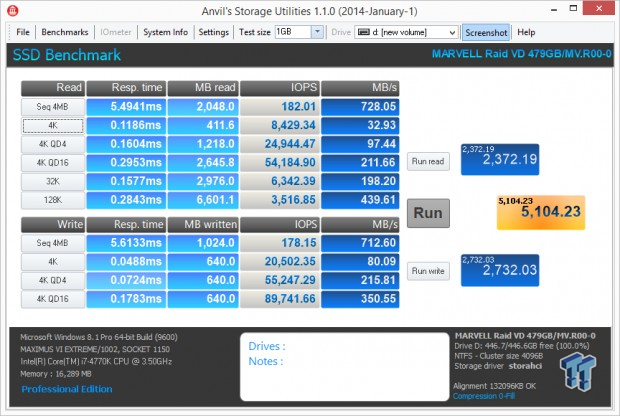
Incompressible Data

The Fujitsu Quadro-M uses SandForce controllers, so there is a performance penalty when writing incompressible data. In the first test, we see both sequential reads and writes over 700 MB/s with compressible data. With incompressible data, the sequential write performance drops to just over 500 MB/s.
Low Queue Depth Read IOPS
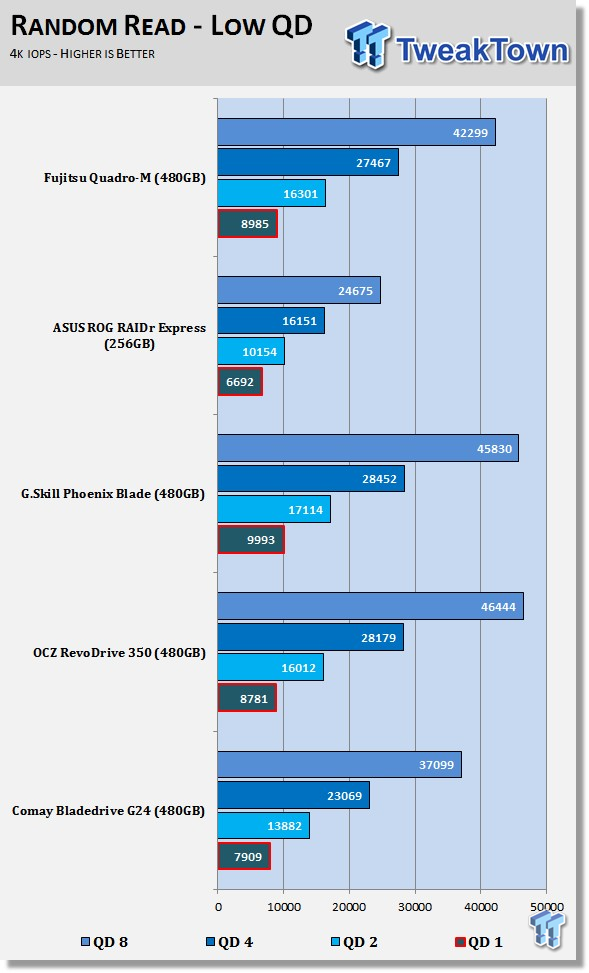
High Queue Depth Read IOPS
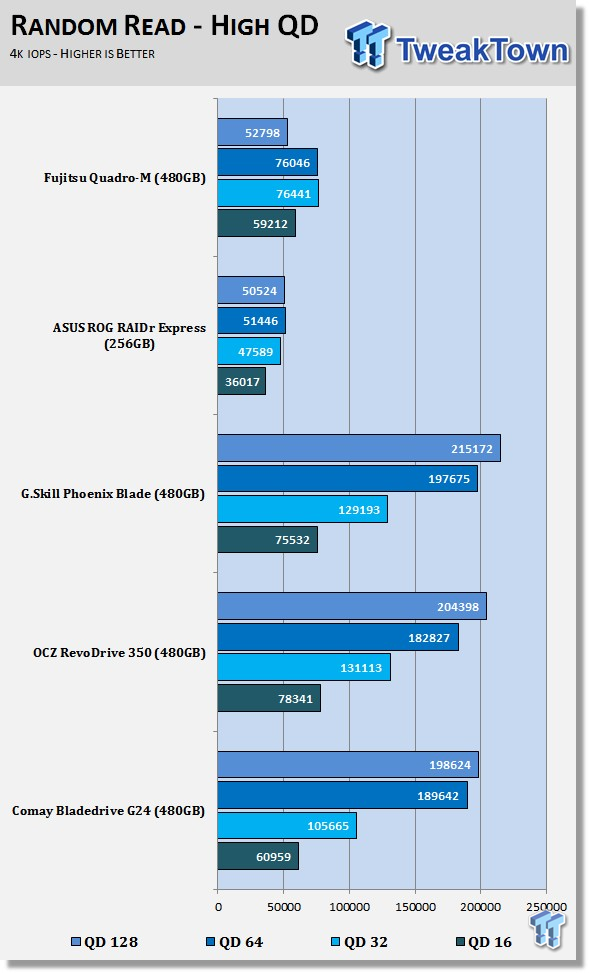
At low queue depths, the Fujitsu Quadro-M 480GB delivers around the same performance you would expect from a single SATA III high performance SSD. The drive scales well as the load increases, but stops just short of 80K random IOPS. The Marvell PCIe to SATA RAID controller was designed as a consumer level product, much like the one used on both the Fujitsu and ASUS ROG RAIDR Express. The other drives on the chart use enterprise SAS controllers that allow the performance to scale to very high levels. In a consumer environment where the user mainly games, surfs the web, or does other day-to-day activities, the user will never get into the high queue depth range.
Low Queue Depth Write IOPS
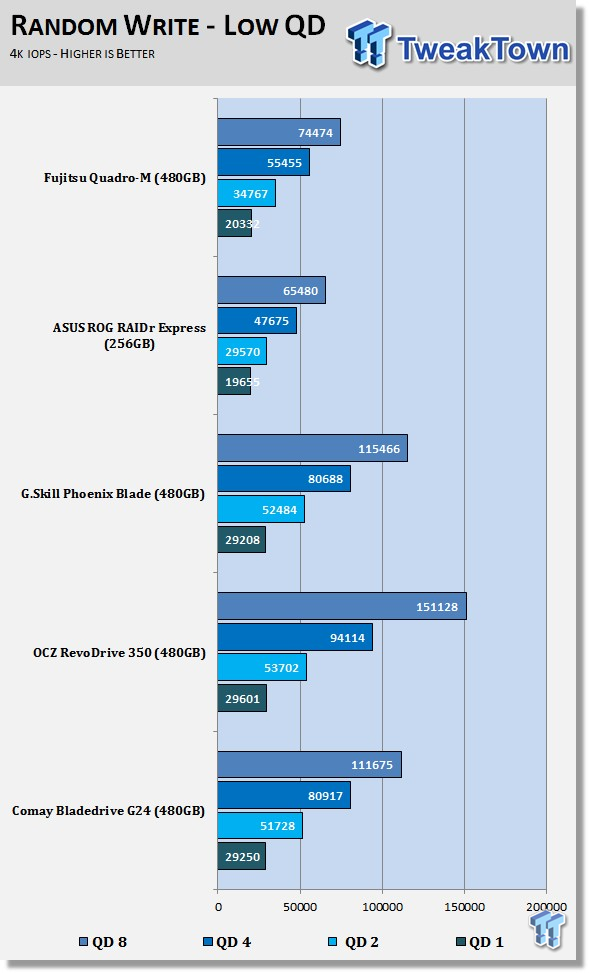
High Queue Depth Write IOPS
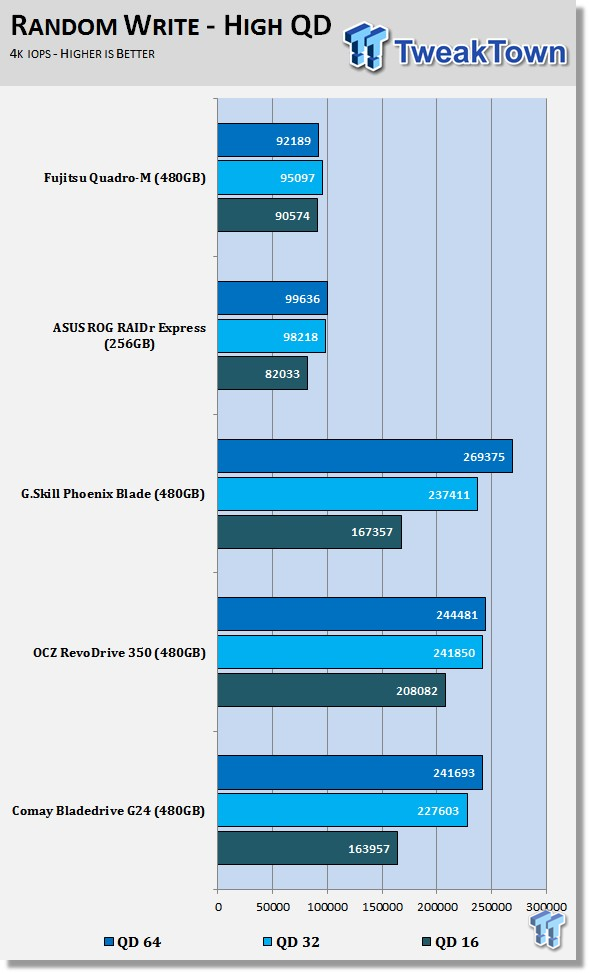
It's interesting to note that in lower queue depths, the Quadro-M outperforms the ASUS RAIDR. At high queue depths, the RAIDR is a bit faster, but again, it's very difficult to get to that level of IO load without heavy multitasking.
Benchmarks - Mixed Read / Write Workloads
Sequential Mixed Read / Write Workloads
In this series of tests, we measure mixed workload performance. We start with 100% read, and then add data writes to the mix in 10% increments until we get to 100% writes. We believe this will be the next major area SSD manufacturers will address, after performance consistency.
Sequential Mixed Workload Bandwidth

Here you'll notice there are four drives on the chart, as we've added the OWC Mercury Accelsior to the mix. The Comay Bladedrive G24 and G.Skill Phoenix Blade both use a Comay PCIe to SAS RAID controller, and that controller has known issues with this specific test.
The Fujitsu Quadro-M 480GB is the first SSD we've ever had produce a reverse bathtub curve in this test. That means the drive is actually faster when reading and writing data at the same time than it is just reading or writing separately.
Sequential 80% Read / 20% Write Bandwidth
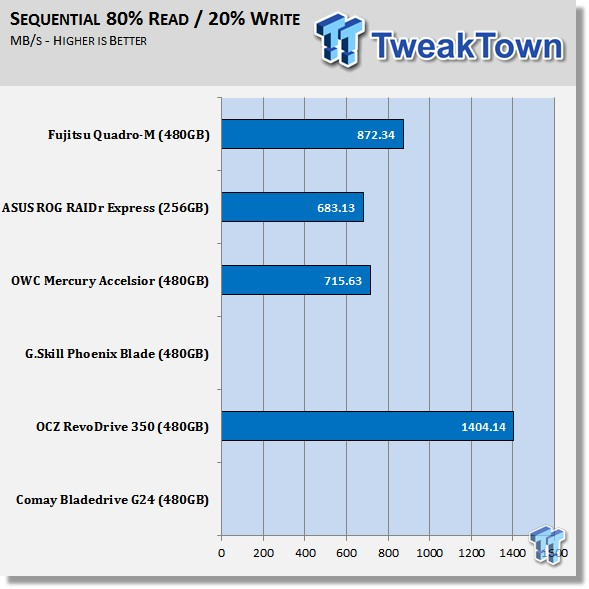
Papers published by storage companies show that an 80% read / 20% write mix should be used to measure consumer workload performance. Here we've isolated that mix and plotted the results. The Fujitsu Quadro-M performed very well here, outperforming both the ASUS RAIDR and OWC Accelsior.
Random Mixed Workload Response Time
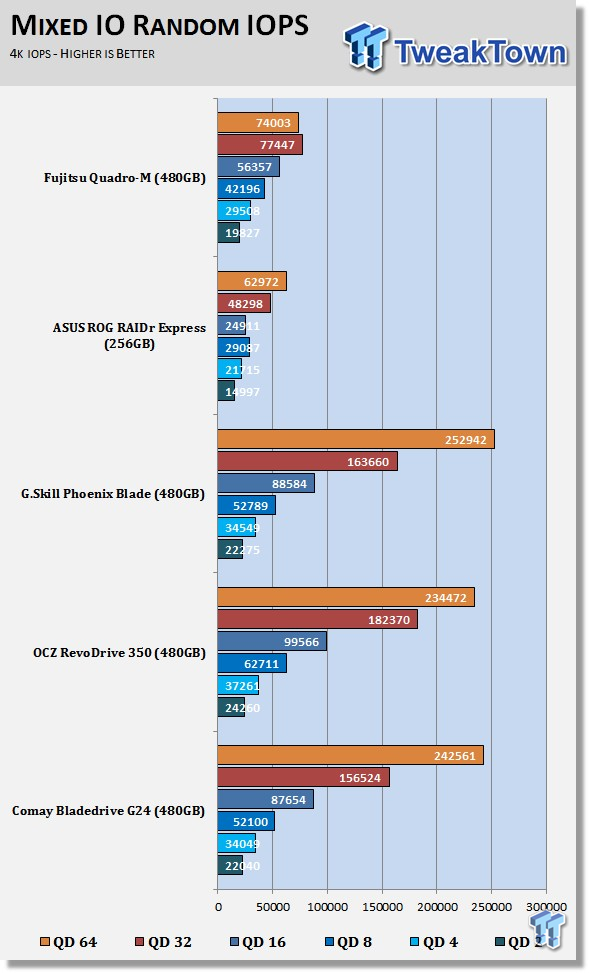
The drive also performed reasonably well in our random mixed workload test. It's still no match for the enterprise controlled drives, but it fares well against the RAIDR.
PCMark 8 Consistency Test
Futuremark PCMark 8 Extended - Consistency Test
Version and / or Patch Used: 2.0.228
Heavy Usage Model:
Futuremark's PCMark 8 allows us to wear the test drive down to a reasonable consumer steady state, and then watch the drive recover on its own through garbage collection. To do that, the drive gets pushed down to steady state with random writes, and then idle time between a number of tests allows the drive to recover.
Precondition Phase:
1. Write to the drive sequentially through up to the reported capacity with random data.
2. Write the drive through a second time (to take care of overprovisioning).
Degradation Phase:
1. Run writes of random size between 8*512 and 2048*512 bytes on random offsets for ten minutes.
2. Run performance test (one pass only).
3. Repeat one and two, eight times, and on each pass, increase the duration of random writes by five minutes.
Steady state Phase:
1. Run writes of random size between 8*512 and 2048*512 bytes on random offsets for 50 minutes.
2. Run performance test (one pass only).
3. Repeat one and two, five times.
Recovery Phase:
1. Idle for five minutes.
2. Run performance test (one pass only).
3. Repeat one and two, five times.
PCMark 8's Consistency test provides a ton of data output that we use to judge a drive's performance. Here we see the three states of performance for select SSDs: light use, consumer steady state, and worst case.
Storage Bandwidth - All Tests
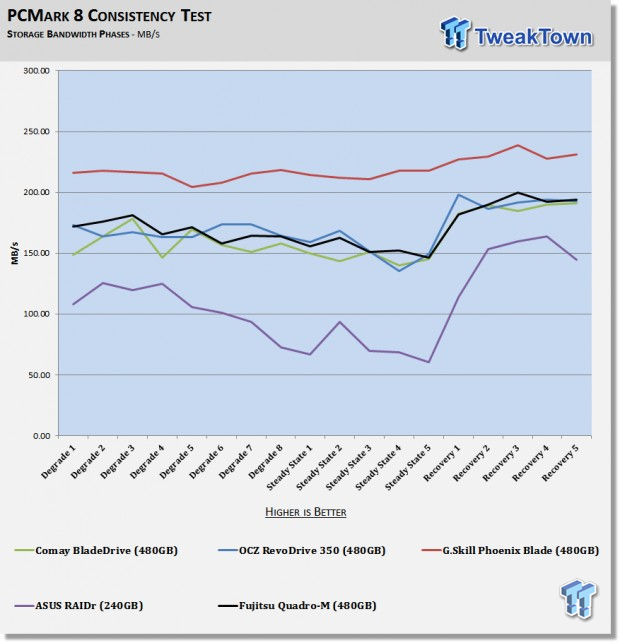
Storage Bandwidth - Heavy Load
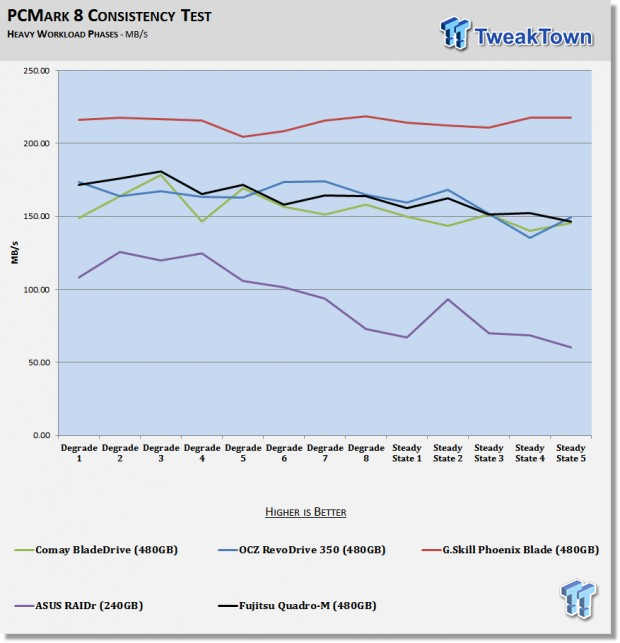
Storage Bandwidth - Typical Consumer Load
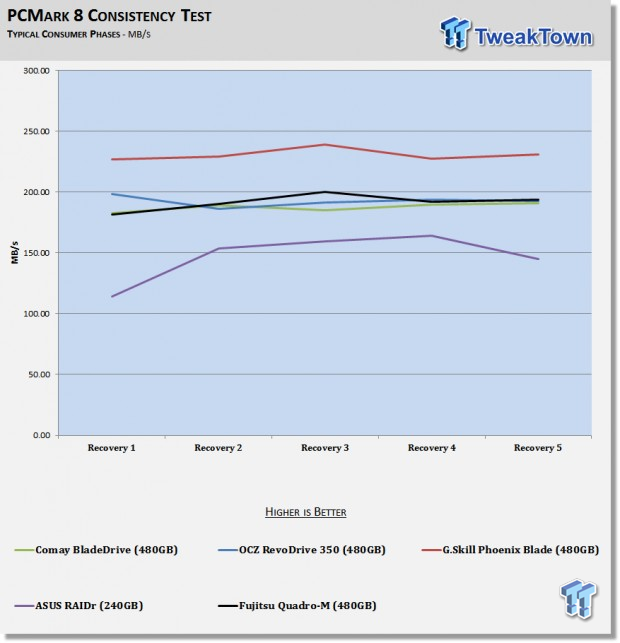
When it comes to real-world application performance, the Fujitsu Quadro-M performs as well as the 480GB OCZ RevoDrive 350 and 480GB Comay BladeDrive G24. Until now, the performance charts showed the two more expensive drives outperforming the Quadro-M, but under heavy load, and even during recovery phases, the Quadro-M managed to keep pace.
PCMark 8 Consistency Test - Continued
Total Access Time - All Tests
The access time test measures the total latency across all 18 tests. This is one of, if not the most important of all tests we run at this time for consumer SSDs. When your latency is low, your computer feels fast; it's just that simple.
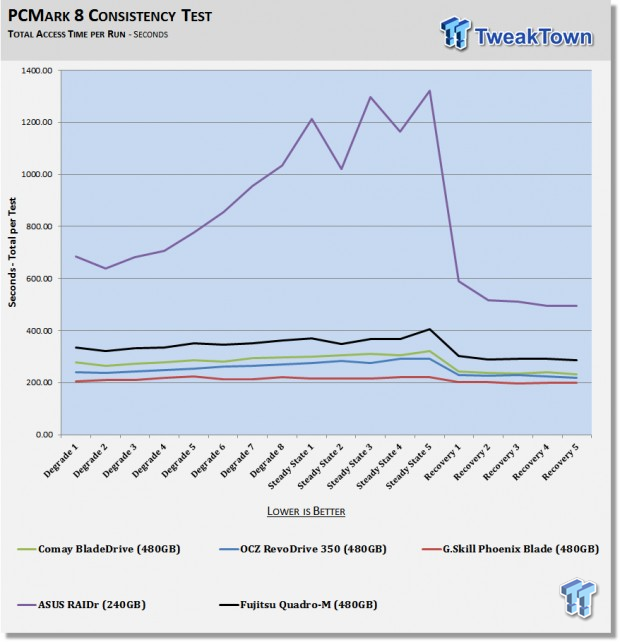
Total Access Time - Heavy Load
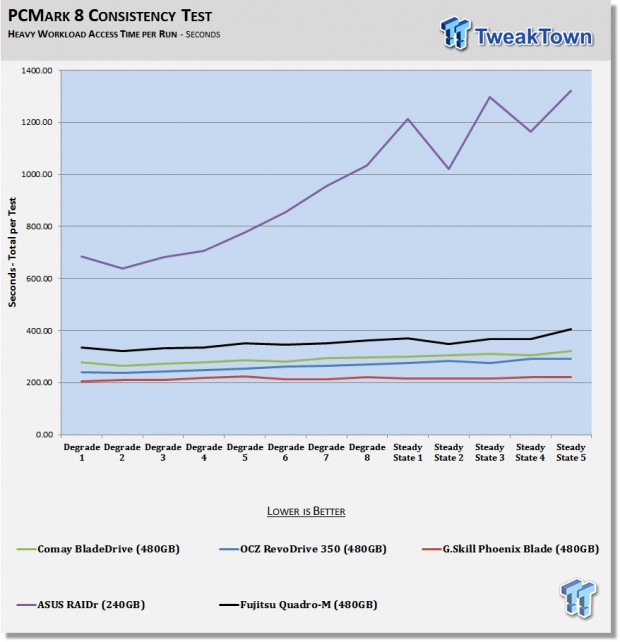
Total Access Time - Typical Consumer Load
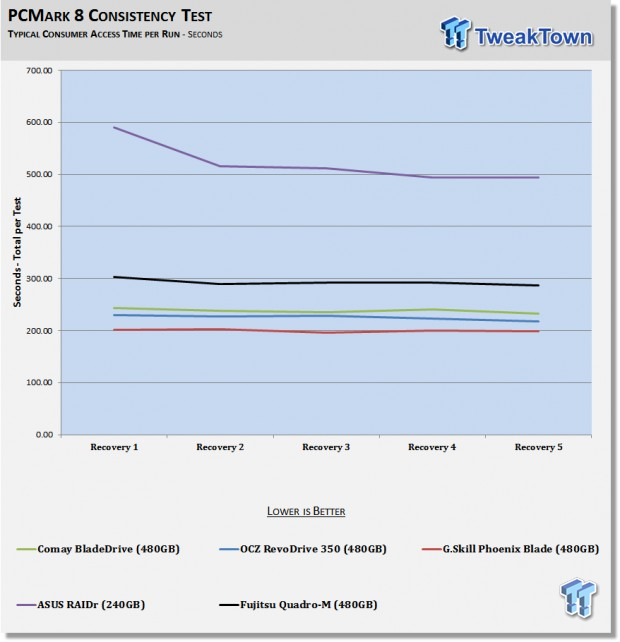
Here we see the latency results from the same tests. Latency, or lack thereof, makes your computer feel fast, and I'd say this is the most important benchmark series in this review. The near enterprise-grade drives have an advantage over the Quadro-M, but our sample drive does much better than the RAIDR.
Final Thoughts

Today's article was more of a performance preview, and not an actual review of a retail product. Fujitsu plans to release the Quadro-M in all three capacities before the end of the year. Final pricing has yet to be set, but we're told the 480GB model we tested today will cost less than $500 MSRP. Given the fact there are four SSDs on board with a combined total of 512GB of NAND flash, the Fujitsu Quadro-M will be the first All-in-One RAID product to launch at less than $1 per GB. That's a really nice achievement given the additional cost associated with designing and developing the extra hardware needed to support the SSDs.
We've spoken with Fujitsu on a number of occasions in the past, and feel we know the company well. We also have a number of their products on hand for early testing, and can say the company's number one focus is on design and build quality. This shows in every product we've handled, and also carries over into other aspects of the products. Fujitsu only uses genuine Intel NAND flash. IMFT manufactures the flash, and it is directly packaged by Intel; it is not purchased in wafers and shipped to a processing company that may or may not make a quality package.
Over the years, we've seen a lot of blacktop NAND pass through our test labs. Most of the time, the flash is good, but you can never tell if it will survive long term. With MLC flash floating around with less than 3K P/E cycles, and profit margins shrinking on consumer products, it is difficult to tell who is using the sub-par flash, and who is still using quality flash. When you only use Intel flash that is rated at 3K or 5K P/E cycles, you know what you are buying, and that's important when your data is on the line. Inside, the Fujitsu Quadro-M is an Intel mSATA drive, not just the flash that was added to a third-party board. Intel makes the flash, and gets first dibs on the parts. It's well known that Intel cherry picks only the best flash for their own products.
Aside from the flash, Fujitsu also took extra steps to insure a quality product. The Marvell controller used has a heat sink on it. We've seen this controller used a number of times without a heat sink, but Fujitsu put in the effort to make sure the customer wouldn't have any issues down the road. The design and quality of the rest of the PCB and components was well thought out. Even the aluminum cover plays a role in protecting the components inside, and adds a bit of bling to the Quadro-M.
This is the second product we've published on TweakTown from Fujitsu. Expect more to come over the next few months, including the FSX Extreme Series that uses single-level cell flash in a SATA drive priced below $1 per GB.
